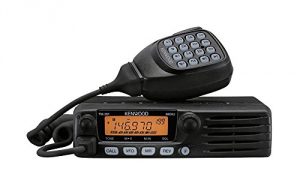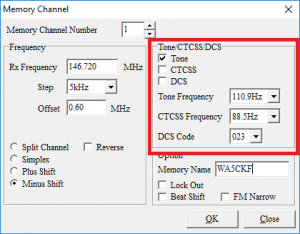I was helping a friend program his new Kenwood TM-281A Two Meter radio, and we had an interesting problem. We had recently performed some maintenance on our local 2M repeater (WA5CKF in Irving, TX) and the programming file I had for the TM-281A didn’t seem to work with the repeater now. We could “open” the repeater, which tells me we had the right PL Tone set, but we heard nothing from the repeater, despite seeing the S meter indicate a signal.
The radio was programmed using Kenwood’s free MCP-1A software, and the repeater was set to have CTCSS set to the proper “110.9” PL Tone. Well, when nothing else seemed to resolve the issue, I referred to the manual, and I tried to divine what the difference was between the “Tone”, “CTCSS”, and “DCS” options were. Well, it wasn’t very helpful, but the manual had a cryptic section on “Selective Call” on page 46, it said:
You may sometimes want to hear calls from only specific persons or groups. In this case, use Selective Call. This transceiver is equipped with CTCSS (Continuous Tone Coded Squelch System) and DCS (Digital Coded Squelch). These Selective Calls allow you to ignore (not hear) unwanted calls from other persons that are not using the same frequency. The Transceiver unmutes only when it receives a signal having the same CTCSS tone or DCS tone.
In other words, when you set CTCSS or DCS tones for a repeater channel the radio only lets you hear signals from repeater that have the proper PL or DCS Tones included.
It turns out our repeater stopped outputting 110.9 PL Tone after the recent maintenance work (by design), and changing the setting on the channel from “CTCSS” to “Tone” at 110.9 caused the radio to transmit the required 110.9 PL Tone, but would break squelch (unmute) on any RF that exceeded the squelch threshold. I tested this change, and it worked as expected.
So, the lesson learned is that when “Tone” is selected the PL Tone is sent on transmit, and no tone is looked for on receive, and “CTCSS” not only transmits the selected PL Tone, but also requires that any received signal include the same PL Tone to break squelch. “DCS” operates in a similar fashion to “CTCSS”, but instead of an audio PL Tone it uses a digital signal. It would have been helpful if Kenwood had spelled this out better on page 24 of the manual, instead of leaving the reader to infer the operation of the “Tone” function as compared to the “CTCSS” function description on page 46.
As a closing note, I quite like the Kenwood MCP-1A radio programming software, it is bare-bones, but it just works. Coupled with the appropriate Kenwood programming cable it makes quick work of programming this excellent mono-band radio.


